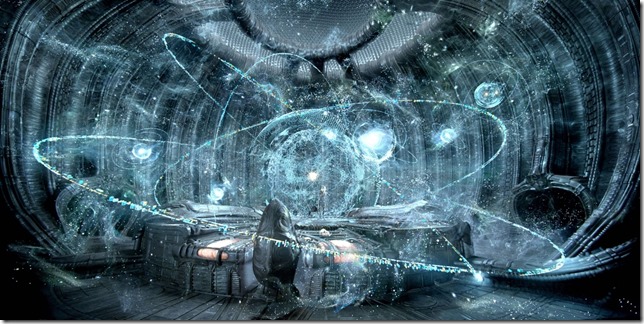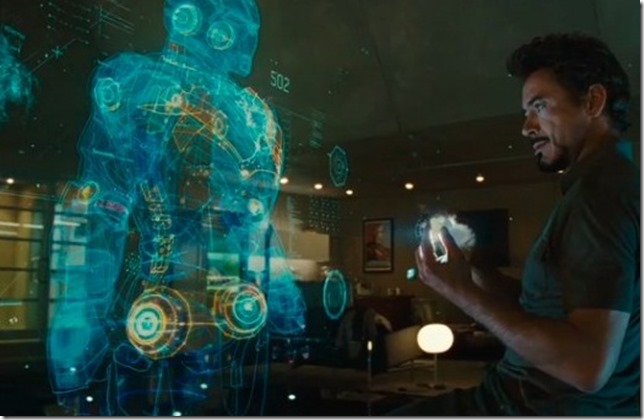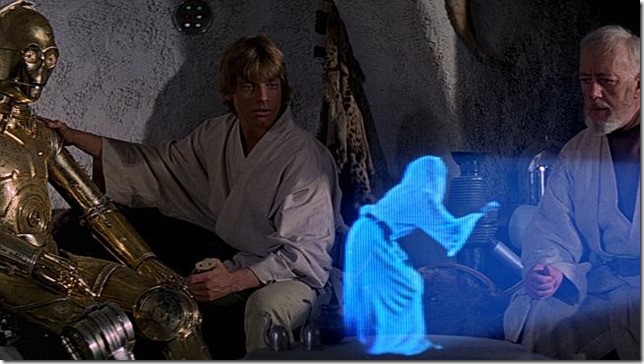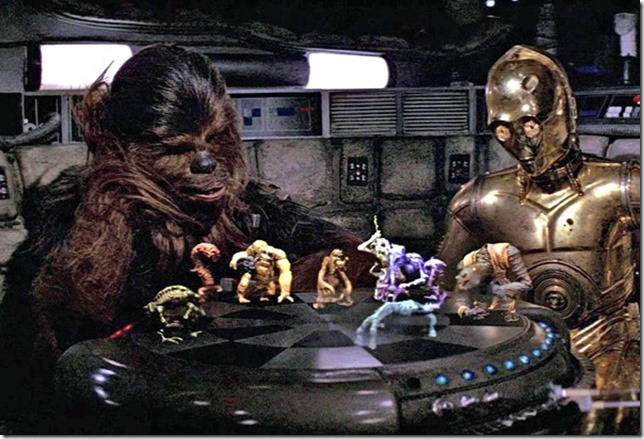[Note: this post is entirely my own opinion and purely conjectural.]
Best current guesses are that the HoloLens field of view is somewhere between 32 degrees and 40 degrees diagonal. Is this a problem?
We’d definitely all like to be able to work with a larger field of view. That’s how we’ve come to imagine augmented reality working. It’s how we’ve been told it should work from Vernor Vinge’s Rainbow’s End to Ridley Scott’s Prometheus to the Iron Man trilogy – in fact going back as far as Star Wars in the late 70’s. We want and expect a 160-180 degree FOV.
So is the HoloLens’ field of view (FOV) a problem? Yes it is. But keep in mind that the current FOV is an artifact of the waveguide technology being used.
What’s often lost in the discussions about the HoloLens field of view – in fact the question never asked by the hundreds of online journalists who have covered it – is what sort of trade-off was made so that we have the current FOV.
A common internet rumor – likely inspired by a video by tech evangelist Bruce Harris taken a few months ago – is that it has to do with cost of production and consistency in production. The argument is borrowed from chip manufacturing and, while there might be some truth in it, it is mostly a red herring. An amazingly comprehensive blog post by Oliver Kreylos in August of last year went over the evidence as well as related patents and argued persuasively that while increasing the price of the waveguide material could improve the FOV marginally, the price difference was prohibitively expensive and ultimately nonsensical. At the end of the day, the FOV of the HoloLens developer unit is a physical limitation, not a manufacturing limitation or a power limitation.
But don’t other AR headset manufacturers promise a much larger FOV? Yes. The Meta 2 (shown below) has a 90 degree field of view. The way the technology works, however, involves two LED screens that are then viewed through plastic positioned at 45 degrees to the screens (technically known as a beam splitter, informally known as a piece of glass) that reflects the image into the user’s eyes at approximately half the original brightness while also letting the real world in front of the user (though half of that light is also scattered). This is basically the same technique used to create ghostly images in the Haunted Mansion at Disneyland.
The downside of this increased FOV is you are loosing a lot of brightness through the beam splitter. You are also losing light based on the distance it takes the light to pass through the plastic and get to your eyes. The result is a see-through “hologram”.
But is this what we want? See-through holograms? The visual design team for Iron man decided that this is indeed what they wanted for their movies. The translucent holograms provide a cool ghostly effect, even in a dark room.
The Princess Leia hologram from the original Star Wars, on the other hand, is mostly opaque. That visual design team went in a different direction. Why?
My best guess is that it has to do with the use of color. While the Iron Man hologram has a very limited color palette, the Princess Leia hologram uses a broad range of facial tones to capture her expression – and also so that, dramatically, Luke Skywalker can remark on how beautiful she is (which obviously gets messed up by the Return of the Jedi). Making her transparent would simply wash out the colors and destroy much of the emotional content of the scene.
The idea that opacity is a pre-requisite for color holograms is confirmed in the Star Wars chess scene on the Millennium Falcon. Again, there is just enough transparency to indicate that the chess pieces are holograms and not real objects (digital rather than physical).
So what kind of holograms does the HoloLens provide, transparent or near-opaque? This is something that is hard to describe unless you actually see it for yourself but the HoloLens “holograms” will occlude physical objects when they are placed in front of them. I’ve had the opportunity to experience this several times over the last year. This is possible because these digital images use a very large color palette and, more importantly, are extremely intense. In fact, because the holoLens display technology is currently additive, this occlusion effect actually works best with bright colors. As areas of the screen become darker, they actually appear more transparent.
Bigger field of view = more transparent , duller holograms. Smaller field of view = more opaque, brighter holograms.
I believe Microsoft made the bet that, in order to start designing the AR experiences of the future, we actually want to work with colorful, opaque holograms. The trade-off the technology seems to make in order to achieve this is a more limited field of view in the HoloLens development kits.
At the end of the day, we really want both, though. Fortunately we are currently only working with the Development Kit and not with a consumer device. This is the unit developers and designers will use to experiment and discover what we can do with HoloLens. With all the new attention and money being spent on waveguide displays, we can optimistically expect to see AR headsets with much larger fields of view in the future. Ideally, they’ll also keep the high light intensity and broad color palette that we are coming to expect from the current generation of HoloLens technology.







